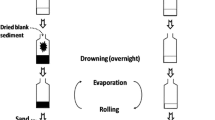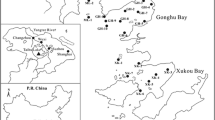Abstract
Determination of estrogenic activity has so far mainly concentrated on the assessment of compounds in surface water and effluent. This study is one of the first to biomonitor (xeno-)estrogens in sediment, suspended particulate matter and aquatic organisms. The relatively polar acetone extracts from these solid phase matrices do not contain the well-known estrogenic compounds such as hormones, alkylphenols and phthalates. An in vitro ‘estrogen receptor-mediated chemical activated luciferase gene expression’ (ER-CALUX) assay was applied to samples from various locations in the Netherlands. Estrogenic activity measured in polar fractions of particulate matter and sediment extracts ranged from below detection limit to up to 4.5 pmol estradiol equivalents (EEQ)/g dry weight. Estrogenic activity in freshwater river sediments was up to five times higher compared to sediments from large lakes and coastal locations. Tissue extracts EEQs were determined in bream (Abramis brama), flounder (Platichthys flesus), freshwater mussels (Dreissena polymorpha) and marine mussels (Mytilus edulis). The highest biota EEQ levels were found in the freshwater zebra mussel (30 pmol EEQ/g lipid). One sample site showed greatly elevated EEQs in sediment and biota, which correlated with effects found in the wild populations of bream. The EEQ activity of the unknown compounds in the polar fraction mostly was much higher than the calculated EEQ levels based on known estrogens in the non-polar fraction (previously published data).
Similar content being viewed by others
References
Belfroid, A.C., Murk, A.J., Van der Velde, E.G., Rijs, G.B.J. and Vethaak, A.D. (1999). Endocrine-disrupting compounds in water systems: a pilot study of the occurrence of estrogenic compounds in surface and waste waters in the Netherlands. RIKZ Report no. 99.024.85 p.
Blaise, C., Gagne, F., Pellerin, J. and Hansen, P.D. (1999). Measurement of a vitellogenin-like protein in the hemolymph of Mya arenaria (Saguenay Fjord, Canada): a potential biomarker for endocrine disruption. Environ. Toxicol. 14, 455-65.
Desbrow, C., Routledge, E.J., Brighty, G.C., Sumpter, J.P. and Waldock, M. (1998). Identification of estrogenic chemicals in STW effluent. 1. Chemical fractionation and in vitro biological screening. Environ. Sci. Technol. 32, 1549-58.
Khim, J.S., Villeneuve, D.L., Kannan, K., Koh, C.H. and Giesy, J.P. (1999). Characterization and distribution of trace organic contaminants in sediment from Masan Bay, Korea. 2. In vitro gene expression assays. Environ. Sci. Technol. 33, 4206-11.
de Lafontaine, Y., Gagne, F., Blaise, C., Costan, G., Gagnon, P. and Chan, H.M. (2000). Biomarkers in zebra mussels (Dreissena polymorpha) for the assessment and monitoring of water quality of the St. Lawrence River (Canada). Aquat. Toxicol. 50, 51-71.
Legler, J. (2001). Development and application of in vitro and in vivo reporter gene assays for the assessment of (xeno-) estrogenic compounds in the aquatic environment. PhD Dissertation, Wageningen University, The Netherlands, 132 pp.
Legler, J., Broekhof, J.L.M., Brouwer, A., Lanser, P.H., Murk, A.J., Van der Saag, P.T., Vethaak, A.D., Wester, P., Zivkovic, D. and Van der Burg, B. (2000). A novel in vivo bioassay for (xeno) estrogens using transgenic zebrafish. Environ. Sci. Technol. 34, 4439-44.
Legler, J., Dennekamp, M., Vethaak, A.D., Brouwer, A., Koeman, J.H., Van der Burg, B. and Murk, A.J. (2002a). Detection of estrogenic activity in sediment-associated compounds using in vitro reporter gene assays. Sci. Total Environ. 293, 69-83.
Legler, J., Jonas, A., Lahr, J., Vethaak, A.D., Brouwer, A. and Murk, A.J. (2002b). Biological measurement of estrogenic activity in urine and bile conjugates with the in vitro ER CALUX reporter gene assay. Environ. Toxicol. Chem. 21(3), 473-9.
Legler, J., Van den Brink, C.E., Brouwer, A., Murk, A.J., Van der Saag, P.T., Vethaak, A.D. and Van der Burg, B. (1999). Development of a stably transfected estrogen receptor-mediated luciferase reporter gene assay in the human T47D breast cancer cell line. Toxicol. Sci. 48, 55-66.
Lemmen, J.G., Van den Brink, C.E.M., Legler, J., Van der Saag, P.T. and Van der Burg, B. (2002). Estrogen receptor mediated estrogenic activity of prenatal steroids using novel ERα and ERβ specific in vitro assays. J. Endocrin. accepted.
Moore, P. (2000). The oestrogenic potential of the phthalate esters. Reprod. Toxicol. 14, 183-92.
Murk, A.J., Legler, J., Van Lipzig, M.M.H., Meerman, A., Belfroid, A.C., Spenkelink, A., Rijs, G.B.J. and Vethaak, A.D. (2002). Detection of estrogenic potency in wastewater and surface water with three in vitro bioassays. Environ. Toxicol. Chem. 21(1), 16-23.
Shore, L.S., Gurevitz, M. and Shemesh, M. (1993). Estrogen as an environmental pollutant. Bull. Environ. Contam. Toxicol. 51, 361-6.
Smit, M.D., Leonards, P.E.G., Madsen, A.B., Van Hattum, B.G.M., Murk, A.J. and De Jongh, A.W.J.J. (1996). Bioaccumulation of PCBs in Danish otter habiatats. Chapter 2. In M.D. Smit, P.E.G. Leonards, A.J. Murk, A.W.J.J. De Jongh and B. Van Hattum (eds) Development of Otter-based Quality Objectives for PCBs. Report no. E-96/11, Institute for Environmental Studies Vrije Universiteit, Amsterdam, 129 pp.
Snyder, S.A., Keith, T.L., Verbrugge, D.A., Snyder, E.M., Gross, T.S., Kannan, K. and Giesy, J.P. (1999). Analytical methods for detection of selected estrogenic compounds in aqueous mixtures. Environ. Sci. Technol. 33, 2814-20.
Tyler, C.R., Jobling, S. and Sumpter, J.P. (1998). Endocrine disruption in wildlife: a critical review of the evidence. Crit. Rev. Toxicol. 28, 319-61.
Vethaak, A.D., Rijs, G.B.J., Schrap, S.M., Ruiter, H., Gerritsen, A. and Lahr, J. (2002). Estrogens and xeno-estrogens in the aquatic environment of The Netherlands. Ministry of Transport and Public Works, The Hague. RIZA/RIKZ Report no. 2002.001. 280 pp..
de Voogt, P., de Wells, D.E., Reutergardh, L. and Brinkman, U.A.T. (1990). Biological activity, determination and occurrence of planar, mono-and di-ortho PCBs. Int. J. Environ. Anal. Chem. 40, 1-46.
de Voogt, P., Kwast, O., Hendriks, R., Jonkers, C.C.A. (2000). Alkylphenol ethoxylates and their degradation products in abiotic and biological samples from the environment. Analysis 28, 776-82.
Author information
Authors and Affiliations
Corresponding author
Rights and permissions
About this article
Cite this article
Legler, J., Leonards, P., Spenkelink, A. et al. In Vitro Biomonitoring in Polar Extracts of Solid Phase Matrices Reveals the Presence of Unknown Compounds with Estrogenic Activity. Ecotoxicology 12, 239–250 (2003). https://doi.org/10.1023/A:1022558911779
Issue Date:
DOI: https://doi.org/10.1023/A:1022558911779




